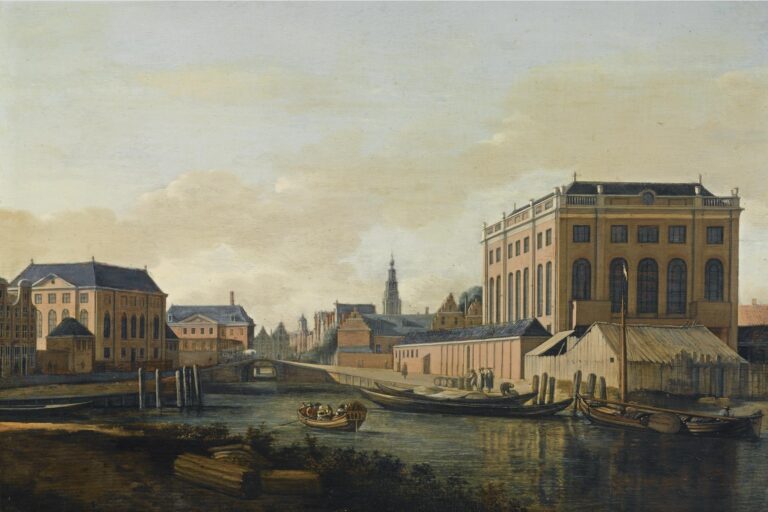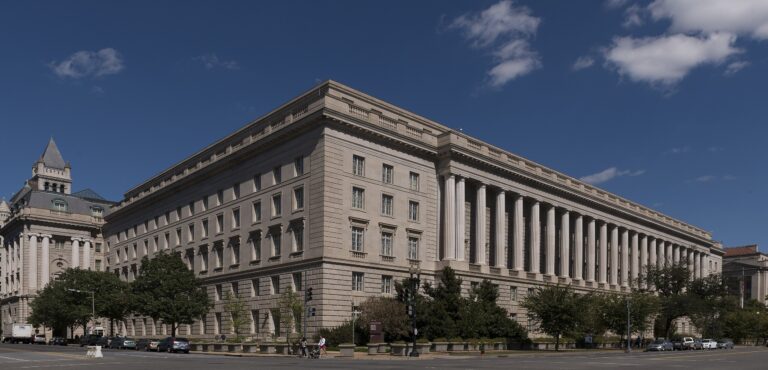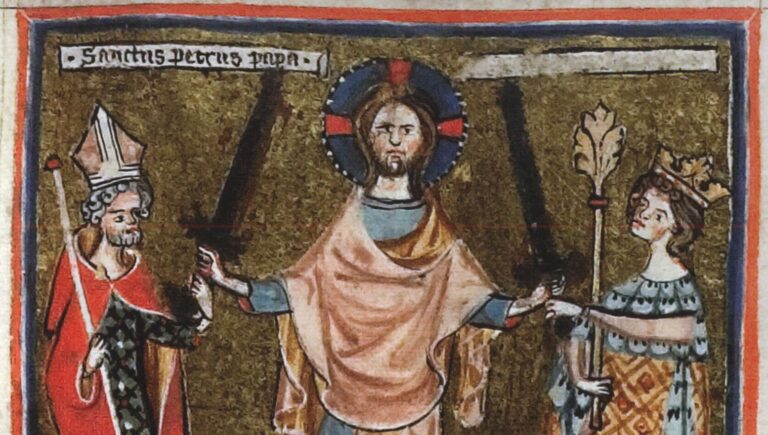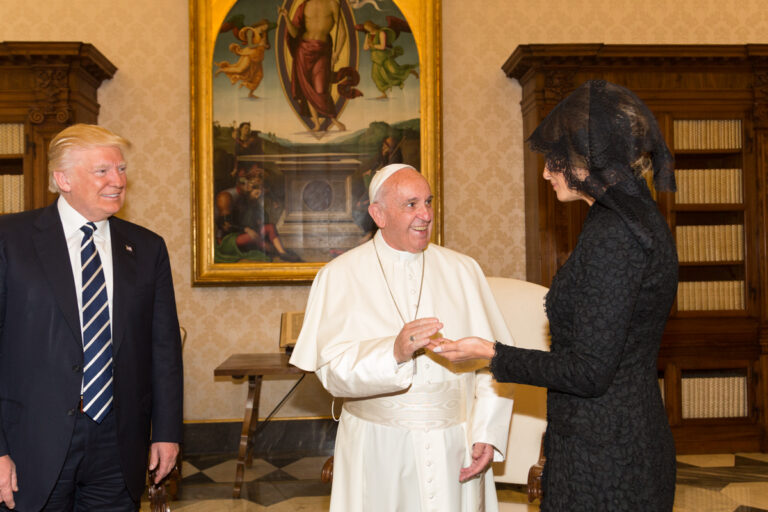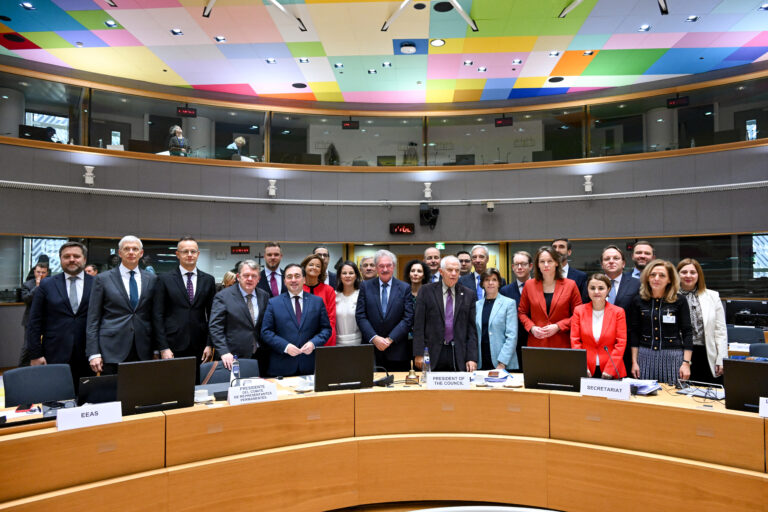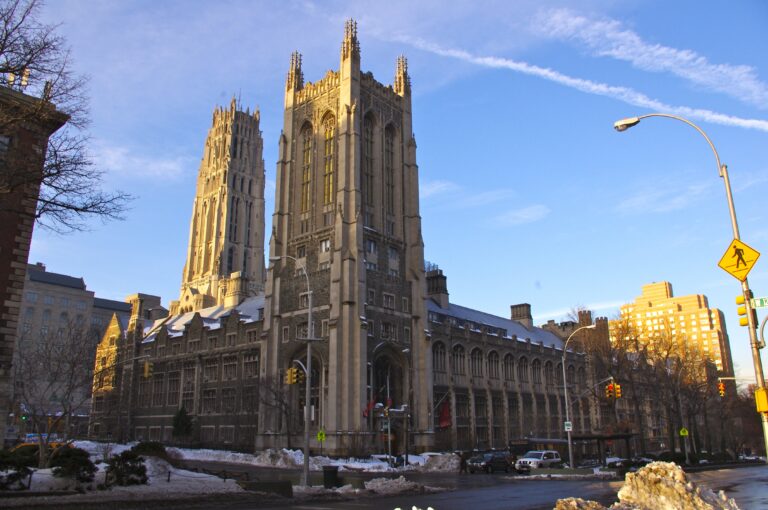
U.S. Refugee and Immigration Policies: the Wages of Cruelty and Indifference
Donald Kerwin
The President and First Lady Meet with His Holiness Pope Francis at the Vatican by Shealah Craighead (CC BY 3.0 US)
This article is part of our series on Law, Religion, and Immigration. If you’d like to explore other articles in this series, click here.
This paper examines U.S. humanitarian, refugee, and immigration policies in light of Catholic Social Teaching (CST). It outlines the biblical roots of the Catholic Church’s enduring concern for migrants and broad themes that undergird its migration-related teachings. It sets forth a framework –“freedom” or “right” to stay, migrate, and return– to assess policy and programmatic responses to refugees and forced migrants. It analyzes through the lens of CST the ideologies and migration policies championed by the second Trump administration, particularly its mass, indiscriminate deportation program and its evisceration of humanitarian assistance and protection programs. It ends with a reflection on the Church’s hopeful vision of refugees, forced migrants, and immigrants, rooted in witness and Scripture.
Catholic Social Teaching and Migration
“Modern” Catholic Social Teaching dates from the late nineteenth century, but draws from biblical themes and a far older theological tradition. It interprets momentous social questions or “signs of the times… in the light of the Gospel.” It consists of the body of authoritative Church documents on social issues, including papal encyclicals and apostolic constitutions, decrees, exhortations, and other sources. The Catechism of the Catholic Church refers to this teaching as a “central and essential element” of the faith.
Biblical Roots
The Church’s teaching on refugees and migrants is deeply rooted in biblical narratives and its own experience of migration and displacement. Fr. Daniel Groody, CSC, writes that the Jewish people “came into being through a migration experience when God called Abraham to leave his homeland and venture forth into new and unknown territory.” Based on this experience, God enjoined them not to “oppress or afflict a resident alien, for you were once aliens residing in the land of Egypt”.
In the New Testament, the Word migrates to redeem sinful humanity, so that human beings can return to God. “Jesus enters the world,” Groody writes, “amidst a drama involving documentation (a census of the entire Roman world, Luke 2:1–5).” Joseph and Mary make the dangerous trip to Bethlehem. The wise men travel to see the newborn, taking a circuitous route home to avoid King Herod the Great. The Holy Family flees to Egypt to escape the same genocidal King, and become, in Pope Pius XII’s words, “ the models and protectors of every migrant, alien and refugee of whatever kind, who whether compelled by fear of persecution or by want, is forced to leave his native land, his beloved parents and relatives, his close friends, and to seek a foreign soil.” They later settled in Galilee, rather than Judea (their place of origin) for fear of its ruler, Archelaus (Matthew 2:22).
In his short, peripatetic adult ministry, Jesus is “othered,” and must occasionally flee from hostile crowds and religious authorities. He laments having nowhere to lay his head. In the parable of the Good Samaritan, he disturbs the assumptions of his listeners and offers a schismatic stranger, a Samaritan, as his model of compassion and love of neighbor. He teaches that all the nations (peoples) of the world will be judged based on their treatment of the stranger and the least. He commissions his disciples to “make disciples of all nations”, and to spread God’s word “to the ends of the earth.” And he returns to his home.
Early Christian writers described their communities as pároikos – guests, strangers, or sojourners. This “self-awareness” had an “eschatological and spiritual” dimension but also reflected the lived experience of Christian communities in Rome, Corinth and Asia Minor, who were “mostly migrants, “without full civic rights” and “subject to discrimination and persecution.” Pároikos is the root of the word “parish”; i.e., where migrants worship and dwell. In the current era, however, fear of deportation prevents many from celebrating their faith.
Over and over, migration serves as the occasion and backdrop for humankind’s experience and encounter with God. From a Judeo-Christian perspective, this stands to reason because, as Pope Francis put it, “the fundamental reality of the Exodus, of every exodus, is that God precedes and accompanies his people and his children in every time and place.” He walks “with his people, but also within them.”
Catholic Social Learning
Catholic Social Teaching emerges less from a process of compiling and integrating documents, than from engagement with affected populations. From the beginning to the end of his pontificate, Pope Francis spoke of the need to empathize with the world’s displaced, and to learn from those living at its margins and borders. Rooted in a “‘culture of encounter’ through dialogue and social friendship,” Catholic Social Learning enables the Church, particularly by listening to the poor, to “see the world through God’s eyes.” This “methodology” or way of being sharply distinguishes Church teaching from politically driven pronouncements and policies. It reflects the Church’s core conviction that the poor, marginalized, and excluded have a “leading role to play” in engaging to their own situations. If not, as Pope Francis warned, “the result would be, once again, ‘a plan drawn up by the few for the few.’”
Migration and Displacement: Why a Consistent Theme?
Why has migration and displacement been an enduring theme of Catholic Social Teaching? Pope Benedict XVI provided a partial answer, describing migration as “a striking phenomenon because of the sheer numbers of people involved, the social, economic, political, cultural and religious problems it raises, and the dramatic challenges it poses to nations and the international community.” The number of international migrants – 304 million living outside their countries of birth – doubled between 1990 and 2024, and the number of forcibly displaced –narrowly defined – reached 123 million at the end of 2024 or 129 million adding others assisted by the United Nations. Migration transforms migrants, and communities of origin, transit and destination. The Church recognizes that states cannot successfully address this “social phenomenon of epoch-making proportions” in isolation: to do so requires instead “bold, forward looking policies of international cooperation.”
Forced migration results from conditions such as war, totalitarianism, environmental degradation, and poverty. Pope Francis used the term “polycrisis” to describe the ways in which “wars, climate changes, energy problems, epidemics, the migratory phenomenon and technological innovation converge.” Forced migrants struggle with the conditions that displace them, the insecurity of irregular migration, and the immense challenge of finding a safe, permanent home. They bear the brunt of ideologies, such as exclusionary forms of nationalism, nativism, and a kind of disengaged “radical individualism,” which CST decries. They also suffer from the divisive, politically-driven policies that result from these “isms.”
Several themes undergird the Catholic Church’s teaching on refugees, forced migrants, and immigrants. The first relates to the source of human dignity. In Catholic thought, human beings are created in God’s image and called to be citizens of His kingdom, as part of a plan that they can only partly divine. This plan does not restrict love of “neighbor” to those in a “closely-knit community of a single country or people,” but extends it to whoever “needs me, and whom I can help.” Unity does not turn on nationality or immigration status, but on the “dignity of every human being,” which “surpasses and sustains every other juridical consideration that can be made to regulate life in society.”
Second, CST prioritizes the poor, marginal, and “least.” In the Beatitudes, Jesus “inaugurated his kingdom by placing the poor at the centre.” He “entrusted to … his disciples” the responsibility to offer hope to those in need. Given this imperative, the “preferential option for the poor” – a core principle of Catholic Social Teaching– is less a preference or an option than a “decision” to help restore marginalized persons to full membership in the human family and to afford them a rightful share in the common good. Leo XIV has decried a “globalization of powerlessness” that extends to all those who have lost heart and fail to act in response to “injustice and innocent suffering” because they have internalized the lie that “nothing can be done.” He has also stressed that communities “must not be freed of the marginalized, but of marginalization . . . not of the desperate, but of desperation.”
The third theme relates to the mission of the Catholic Church – “to gather together God’s scattered children” and to serve as a “sign and instrument of intimate union with God, and of the unity of the whole human race.” In bringing together diverse persons and groups, migration offers a “providential opportunity” to fulfill God’s “plan for a universal communion.” The Church has historically asserted its sovereignty over spiritual matters (souls), and it still asserts a kind of sovereignty over the practice of faith, including the imperative to serve and accompany refugees and immigrants. It believes sovereign states cannot legitimately prevent it from living the Gospel.
The fourth concerns its teaching on states. On the one hand, CST recognizes the authority of states to regulate borders in ways that respect human dignity and to protect their residents. As Saint John Paul II put it: “It is obviously the task of Governments to regulate the migratory flows with full respect for the dignity of the persons and for their families’ needs, mindful of the requirements of the host society.” To Pope Francis, “an authentic rule of law” and the “true common good” should not impede “policy that regulates orderly and legal migration.”
On the other hand, the Catholic Church vests states with responsibilities. It views them as “privileged agents” – akin to the main guarantors – of the “common good,” defined as “the sum of those conditions of social life which allow social groups and their individual members relatively thorough and ready access to their own fulfillment.” It insists that states safeguard forced migrants in transit and provide displaced persons with safe, permanent homes. Cardinal Fabio Baggio describes the unacceptable alternative: “Abuse, deception, exploitation, violence, kidnappings, blackmail, and torture [which] have become so frequent that they are now considered characteristic features of the migration experiences of the third millennium.” To Baggio, the “short-term challenge” is a stark one: “to save lives.”
CST does not confine state responsibilities to their borders. It maintains that the common good has assumed “an increasingly universal complexion and consequently involves rights and duties with respect to the whole human race.” Pope Paul VI (1965) offered a rationale– interdependence– for promoting a universal or border-less vision of the common good. Pope Francis criticized nationalist ideologies that cannot produce “a better world for the whole human family” or “save us from the many ills that are now increasingly globalized.”
The “Freedom” or “Right” to Stay, Migrate, and Return
From its own lived experience and its processes of learning and teaching, the Catholic Church has developed an interpretive, ethical framework – the freedom or right to stay, migrate, and return – to understand human mobility, “guide the development of law and policy …and strengthen humanitarian and development programs.” The framework speaks to the “right” or “freedom” of human beings to thrive in their home communities, to move (when staying becomes impossible) to situations that are consonant with human dignity, and to return home if conditions permit. These rights – some codified, some not – privilege human agency by recognizing that migrants and their families ultimately decide whether to stay or migrate. The right to stay, migrate and return also recognizes the responsibilities of states to:
- Establish the conditions that permit residents to remain at home or where they have settled and made a home.
- Create secure, legal migration options, particularly for forced migrants, which states have long failed to do.
- Facilitate the safe and voluntary return of forced migrants to their home communities.
Freedom to Stay
The Catholic Church’s overriding concern related to the right to stay has been to identify and establish the conditions that allow migrants or potential migrants to flourish, whether in their communities of origin or settlement. Saint John Paul II recognized the “basic human right to live in one’s own country,” a right realized by controlling the conditions that compel “people to emigrate,” including “civil conflicts, wars, the system of government, unjust distribution of economic resources, inconsistent agricultural policies, irrational industrialization and rampant corruption.” In addition, Catholic teaching does not support two-tiered societies. In a 1986 statement, the National Conference of Catholic Bishops declared: “It is against the common good and unacceptable to have a double society, one visible with rights and one invisible without rights–a voiceless underground of undocumented persons.”
Freedom to Migrate
The freedom to stay requires “creating in countries of origin the conditions needed for a dignified life and integral development.” Yet states regularly fail – for reasons understandable (poverty and cannibalization by other states and powerful non-state actors), inexcusable (the predatory behavior of their leaders), or a combination of both – to meet this responsibility. Yet if individuals find it impossible to stay in their home communities or where they currently reside, they should be allowed to migrate legally and securely to a better situation.
The right to migrate advances human dignity and equality by saving lives and improving the prospects of the poor and dispossessed. Based on an analysis of massive wage gaps between “observably identical, low-skill workers” in the United States and in Haiti, Nigeria, Egypt, and elsewhere, the economist Michael Clemens found that even partially liberalizing migration to wealthy states would exceed “all remaining gains from eliminating barriers to trade and capital flows.” In short, migration should be viewed as an immense opportunity and a form of development. It allows people to sustain themselves and their families, to support their communities of origin and destination, and to “develop” in the ways God wants them to develop.
Freedom to return
Pope Pius XII (1952) spoke to the importance of allowing “exiles and refugees to return finally to their homes” and for “those in need, whose own lands lack the necessities of life, to emigrate to other countries.” Saint John Paul II (1981) treated the rights to emigrate and return as parallel rights: “man has the right to leave his native land for various motives–and also the right to return–in order to seek better conditions of life in another country.” The conditions that permit residents to stay, whether to flourish or at least subsist, cohere with those that allow forced migrants to return home. Thus, honoring the right to stay can facilitate the right to voluntary and safe return. The latter is a core “durable solution” for refugees and one that reflects the hope and preference of most of the world’s forcibly displaced persons.
Catholic Social Teaching and Signature Trump Administration Policies
The draconian policies of the second Trump administration have rapidly surpassed the restrictive laws and practices of past administrations and the first Trump presidency. The administration rejects the consensus of past presidencies regarding the national interests served by U.S. immigration policies. And, it has reliably deployed nativist “language” and conspiracy theories in support of its agenda.
Exclusionary nationalism, nativism and Catholic Social Teaching
Support for the Trump administration’s refugee and immigration policies has been attributed to a range of socio-economic, political, national security and cultural concerns. However, it is also the case, as documented by the Marshall Project and many other sources, that in his public life Donald Trump has consistently described refugees and immigrants in inaccurate, demeaning and inflammatory terms to mobilize his supporters and advance his policies.
CST does not “other.” It opposes ideologies that seek to dominate human beings, subvert their rights and freedoms, and make them indifferent to human suffering. Pope Pius XII (1952) “condemned severely the ideas of the totalitarian and the imperialistic state, as well as that of exaggerated nationalism.” These ideologies, he averred, “arbitrarily restrict the natural rights of people to migrate”, while forcing “entire populations to migrate into other lands, deporting inhabitants against their wills, disgracefully tearing individuals from their families, their homes and their countries.” He proposed instead to allow “exiles and refugees to return” to their homes and for “those in need, whose own lands lack the necessities of life, to emigrate to other countries.” Pope Francis (2020) attributed the rise of “a myopic, extremist, resentful and aggressive nationalism,” to “the deeper tendency to radical individualism,” reflected in the attitude of “globalized indifference.”
Nativism offers a rationale and rhetoric that supports virulent forms of nationalism. It portrays refugees and immigrants as a threat to “the state’s culture, safety, health, wealth, identity, or survival” and the cause of its most vexing social problems. By contrast, Catholic Social Teaching reveres forced migrants, the poor, and the marginalized. Pope Francis exhorted “the faithful … and all men and women of good will, not to give in to narratives that discriminate against and cause unnecessary suffering to our migrant and refugee brothers and sisters.” More recently, Pope Leo XIV said: “Peace is built in the heart and from the heart, by eliminating pride and vindictiveness and carefully choosing our words. For words too, not only weapons, can wound and even kill.”
The Problem of Mass Deportation
In 2023, the U.S. undocumented population reached 12.2 million, slightly exceeding the previous high of 12 million in 2008. The Trump administration has consistently characterized undocumented residents as criminals and worse. Instead, most enjoy “multi-faceted connections… to US society as parents of U.S. citizens and lawful permanent residents (LPRs), laborers, employers, homeowners, professionals and [even] carpoolers.” Thirty-one percent of the undocumented have lived in the United States for at least 18 years. During the COVID-19 crisis, undocumented immigrants and refugees disproportionately served U.S. society as “essential workers.”
The second Trump administration, like the first, has sought to strip legal status from hundreds of thousands of persons who received temporary status on humanitarian grounds, including humanitarian parolees and Temporary Protected Status recipients.
Expanded detention in deplorable conditions in prison-like facilities looms large in the administration’s mass deportation program. Thirty-years ago, the U.S. increased its detention bed space to 8,600 per night. After rising dramatically over many years, the number of immigrant detainees fell to 14,200 a night during the COVID-19 pandemic. As of October 2025, Immigration and Customs Enforcement (ICE) held 60,000 detainees per night, and 20 persons had died in its custody during the year, already the highest detention death toll in more than 20 years. The budget reconciliation process, resulting in H.R.1 – One Big Beautiful Bill Act, produced $45 billion in additional funding for immigrant detention. This increase translates into 118,000 beds per night and 1.4 million detainees per year, assuming an average stay of 30 days. Detention growth will create a windfall for private prison corporations that administer the facilities holding 90 percent of detainees.
The administration’s mass deportation program has led and will increasingly lead to the detention of those without criminal records. To that end, a recent decision of the U.S. Board of Immigration Appeals forbids the release on bond of persons who entered the country without inspection, which is a civil offense and a criminal misdemeanor. Expansion of the U.S. immigrant detention system will not, however, affect most non-citizens serving prison sentences, who have long been ordered deported before their incarceration ends.
The mass deportation initiative needlessly separates families (deporting parents, even those willing to bring their U.S citizen children with them), labors under an extraordinarily high ICE arrest quota of 3,000 per day, entails warrantless arrests, and imperils deportees by removing them to third countries. As discussed below, it has also targeted asylum seekers, who have a legal right to seek asylum and have their claims fairly considered. ICE itself, which H.R. 1 will supersize, is recruiting agents by waiving age limits, offering substantial financial bonuses, and characterizing ICE employment as a “divinely ordained mission.” A DHS recruitment video cites Isaiah 6:8 in support of the Border Patrol’s work: “Then I heard the voice of the Lord saying, ‘Whom shall I send and who will go for us?’ I said, ‘Here am I, send me.’”
Pope Francis (2025) strongly opposed the criminalization of immigrants based solely on their immigration status. He viewed the U.S. mass deportation program as a “major crisis,” declaring: “The rightly formed conscience cannot fail to make a critical judgment and express its disagreement with any measure that tacitly or explicitly identifies the illegal status of some migrants with criminality.” Saint John-Paul II (1993) identified “arbitrary imprisonment” and “deportation” as “intrinsically evil.”
In a powerful talk at the outset of the second Trump administration, His Eminence Robert Cardinal McElroy of the Archdiocese of Washington, D.C. urged the United States to “reclaim the notion in our culture and society that most of the undocumented are the Good Samaritan. They sacrifice for their families. They work hard and they build up our society. They bring good values to our nation. They bring a sense of solidarity, a strong sense of family, of what it means to go without so that your children can have a better life.”
Suspending Refugee Resettlement
At the start of its second term, the Trump administration paused and indefinitely suspended the U.S. Refugee Admissions Program (USRAP), one of the most successful humanitarian programs and public/private partnerships in U.S. history, which had admitted roughly 3.2 million refugees since 1980. One of the administration’s early Executive Orders characterized refugee admissions as “detrimental” to U.S. interests. Yet, USRAP saved millions of lives, offered hope to the world’s neediest citizens, and immensely benefitted U.S. communities.
Resettlement in a third country is an option or “durable solution” for less than one percent of the world’s refugees, but these refugees are typically at greatest risk in the places to which they have fled and where they reside. The Presidential Determination for Refugee Admissions for 2026 set the lowest admissions ceiling, 7,500, in the program’s history, and announced the program would primarily resettle White Afrikaners from South Africa and so-called “other victims of illegal or unjust discrimination in their respective homelands.” Yet the administration has refused to admit and resettle refugees previously approved for admission, including Afghans who had worked with U.S. officials during the war in Afghanistan. After years of waiting, these refugees must begin anew the interminable, uncertain, and dangerous process of trying to find a secure and permanent living situation.
The administration has also decimated the public/private resettlement infrastructure, built over decades and has pressured long-term resettlement partners to abandon this work. In short, the U.S. has become an unreliable partner to the foreign nationals who risked their lives for it and to the faith communities and non-governmental organizations that implemented its overseas and domestic refugee programs.
Denial of Access to the Asylum System
Denial of access to the asylum system – however meritorious the claim – has become a pillar of U.S. policy. Under the Trump administration, Border Patrol agents have expelled migrants from U.S. territory, informing some that the only permissible migration is away from the U.S. By the end of the Biden administration, the “only option” for the overwhelming majority of persons seeking asylum at the U.S.-Mexico border was to schedule an appointment through the CBP One application and to appear at a port-of-entry at the assigned time. By immediately cancelling all previously scheduled CBP One interviews and ending the application’s scheduling function, the Trump administration effectively ended asylum at the border. It also converted CBP One into CBP Home, which allows non-citizens to inform the government that they are “voluntarily” leaving the country.
ICE trial attorneys have urged immigration judges (IJs) to dismiss cases against asylum-seekers and others. ICE agents then arrest and move to deport them under the expedited removal law if they have resided in the United States for less than two years. ICE agents have also arrested affirmative asylum applicants (not in removal proceedings) at their asylum interviews before U.S. Citizenship and Immigration Service (USCIS) asylum officers. Meanwhile, detained asylum-seekers are not being released into the community. In addition, H.R. 1 established multiple fees for asylum-seekers, including to apply for asylum, to work, for renewal permits, and to continue their cases. H.R. 1 also increases fees for virtually all other persons within or seeking to enter the United States on humanitarian grounds.
On June 25, 2025, the administration amended and finalized an Asylum Cooperative Agreement with Honduras. The agreement permits Honduras to consider certain “protection requests” first made in the United States, such as from persons seeking asylum or temporary protection. It allows ICE to pretermit (deny without a hearing) asylum cases from Central Americans (other than Hondurans) and deport asylum-seekers to Honduras. IJs can do little to stop this process unless applicants in removal proceedings can establish a fear of persecution or torture in Honduras, not in their home countries.
The U.S. asylum system never offered an easy path to asylum, either before an IJ or a USCIS asylum officer. Under the law, asylum-seekers at the border and now elsewhere must pass a “credible fear” (of persecution) screening in order to seek asylum in removal proceedings before an IJ. If they cannot do so, they face expedited removal. Immigration Court proceedings are, in any event, adversarial, with the equivalent of a government (ICE) prosecutor. Asylum-seekers and others in removal proceedings can be represented by counsel, but only at their own expense. The legal standards for asylum and related relief are narrow, covering only a fraction of forced migrants. The statutory right to apply for asylum still exists, but it is now mostly honored in the breach.
A Reflection on Hope
Catholic Social Teaching offers a hopeful, reverent vision of refugees, forced migrants, and immigrants. In the earliest statements of his pontificate, Pope Leo XIV characterized migrants as a gift to the Church and the world. The Holy Father titled his first Message for World Day of Migrants and Refugees, “Migrants, missionaries of hope.” In it, he stressed that migrants represent a source of inspiration, reminding the Church of its “pilgrim dimension, perpetually journeying towards her final homeland, sustained by a hope that is a theological virtue.” He called migrants “privileged witnesses of hope,” which they illustrate “through their resilience and trust in God, as they face adversity while seeking a future in which they glimpse that integral human development and happiness are possible.”
In this era of mass deportation, cruelty masquerading as strength, and unprevented preventable deaths, Pope Leo XIV calls people of good faith to take hope and model migrants in searching for a better, more dignified life. God always “goes before us” on our journeys, he reminds us, “even at times when injustice and death seem to prevail.” Christians can take hope in their conviction that God has a plan and “special place in his heart” for refugees, forced migrants, and the oppressed, especially in the darkest times. Christians believe that the Son of Man will judge them based on their solidarity with “the least.” They know that God views those “who hunger and thirst for righteousness” as “Blessed” and teaches that they “will be satisfied.” ♦

Donald Kerwin is Vice-President for Advocacy, Research and Partnerships for the Jesuit Refugee Service/USA. Kerwin has held leadership positions in the Catholic Legal Immigration Network Inc. (CLINIC), the Migration Policy Institute (MPI), and the Center for Migration Studies of New York (CMS). He has also served on many boards, special commissions, and advisory groups. Bio
Recommended Citation
Kerwin, Donald. “U.S. Refugee and Immigration Policies: the Wages of Cruelty and Indifference.” Canopy Forum, November 14, 2025. https://canopyforum.org/2025/11/14/u-s-refugee-and-immigration-policies-the-wages-of-cruelty-and-indifference/.
Recent Posts


